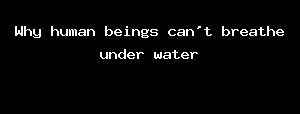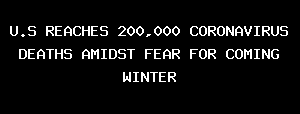profile/8390IMG_20200720_161813_4.jpg
Seersam

Why Human Beings Can't Breathe Under Water
~2.4 mins read
The answer is simply the difference in respiratory systems in terrestrial versus marine organisms. Respiration in humans starts by the passage of air carrying oxygen and carbon dioxide from the nose through the trachea to the lungs. The bronchi inside the lungs narrow gradually until oxygen flows from the lung membranes into the bloodstream. Exhaled air carries carbon dioxide from blood cells as a result of the process of feeding cells with glucose, which takes only a few seconds.Water molecules are made of covalently bonded gases—two hydrogen atoms and one oxygen atom—that need a lot more energy to break the atoms apart to release oxygen. The lining of the human lung is not designed to carry out such a process, and a person would die before having sufficient oxygen rates to resume breathing. Moreover, the lungs will not benefit from oxygen in its atomic state.Extraction of the dissolved oxygen out of the water is not easy, because water density exceeds that of air, and air has 20 times more oxygen than water. The main reason for fish ability to breathe underwater is the fact that fish are cold-blooded, which means they need small oxygen amounts to complete the breathing process. Some warm-blooded marine organisms, such as whales and dolphins, have difficulty in extracting enough oxygen using gills; thus, they head to the surface of the water to grasp some air.Fish also need oxygen to survive, although they do not breathe oxygen from water molecules (H2O); the gills extract the dissolved oxygen from water. Indeed, several gases can dissolve in liquids; we can see this in soft drinks where huge amounts of carbon dioxide are dissolved in soda, appearing in the form of bubbles when the container is opened.Amphibians are the link between terrestrial and marine organisms, because they depend on the lungs, skin, and sometimes gills to complete the breathing process. They begin to breathe using the skin by secreting mucous substances to maintain skin moisture and absorb oxygen, which in turn moves to the capillaries near the skin surface, then to all body cells. It is worth mentioning that amphibians absorb more than one-quarter of the amount of oxygen they consume during respiration through the skin; in case the skin is dry, they cannot breathe and die. Some amphibians, such as tadpoles—a larval stage in the lifecycle of a frog—do not rely solely on the lungs or skin, and use their nostrils to carry out the breathing process, similar to fish gills. The reason is that these amphibian tadpoles stay in water during a certain period of their growth.Last but not least, chemistry always surprises us by its exciting interactions and brilliant colors. Some elements react together to produce the same compounds with the same molecular formula; however, when they are studied closely, we discover they are completely different when consumed by different organisms.Do you like this article??
profile/8390IMG_20200720_161813_4.jpg
Seersam

U.S REACHES 200,000 CORONAVIRUS DEATHS AMIDST FEAR FOR COMING WINTER
~5.9 mins read
The US death toll from the coronavirus topped 200,000 on Tuesday, a figure unimaginable eight months ago when the scourge first reached the world’s richest nation with its sparkling laboratories, top-flight scientists and stockpiles of medicines and emergency supplies.“It is completely unfathomable that we’ve reached this point,†said Jennifer Nuzzo, a Johns Hopkins University public health researcherThe bleak milestone, by far the highest confirmed death toll from the virus in the world, was reported by Johns Hopkins, based on figures supplied by state health authorities.But the real toll is thought to be much higher, in part because many COVID-19 deaths were probably ascribed to other causes, especially early on, before widespread testing.The number of COVID-19 deaths in the US is equivalent to a 9/11 attack every day for 67 days. It is roughly equal to the population of Salt Lake City or Huntsville, Alabama.And it is still climbing. Deaths are running at close to 770 a day on average, and a widely cited model from the University of Washington predicts the US toll will double to 400,000 by the end of the year as schools and colleges reopen and cold weather sets in. A vaccine is unlikely to become widely available until 2021.“The idea of 200,000 deaths is really very sobering, in some respects stunning,†Dr Anthony Fauci, the government’s top infectious-disease expert, said on CNN.News|Coronavirus pandemicCOVID-19: US reaches ‘unfathomable’ 200,000 death tollA photograph of 75 year old Constance Duncan, who died from COVID-19 on her birthday, is show at a memorial to remember the 200,000 Americans who have died from the disease [Win McNamee/Getty Images via AFP]22 Sep 2020The US death toll from the coronavirus topped 200,000 on Tuesday, a figure unimaginable eight months ago when the scourge first reached the world’s richest nation with its sparkling laboratories, top-flight scientists and stockpiles of medicines and emergency supplies.“It is completely unfathomable that we’ve reached this point,†said Jennifer Nuzzo, a Johns Hopkins University public health researcher.KEEP READINGBritain finally launches COVID-19 app in England and WalesOne-dose COVID-19 vaccine tested as US experts say no corners cutUS stocks mixed as Nike sets record, Tesla fails to liftPandemic exacerbates barriers to voting for homeless AmericansThe bleak milestone, by far the highest confirmed death toll from the virus in the world, was reported by Johns Hopkins, based on figures supplied by state health authorities.But the real toll is thought to be much higher, in part because many COVID-19 deaths were probably ascribed to other causes, especially early on, before widespread testing.The number of COVID-19 deaths in the US is equivalent to a 9/11 attack every day for 67 days. It is roughly equal to the population of Salt Lake City or Huntsville, Alabama.And it is still climbing. Deaths are running at close to 770 a day on average, and a widely cited model from the University of Washington predicts the US toll will double to 400,000 by the end of the year as schools and colleges reopen and cold weather sets in. A vaccine is unlikely to become widely available until 2021.“The idea of 200,000 deaths is really very sobering, in some respects stunning,†Dr Anthony Fauci, the government’s top infectious-disease expert, said on CNN.The US hit the threshold six weeks before a presidential election that is certain to be in part a referendum on President Donald Trump’s handling of the crisis.In an interview on Tuesday with a Detroit TV station, Trump boasted of doing an “amazing†and “incredible†job, adding: “The only thing we’ve done a bad job in is public relations because we haven’t been able to convince people – which is basically the fake news – what a great job we’ve done.â€And in a pre-recorded speech at a virtual meeting of the United Nations General Assembly (UNGA), Trump lashed out at Beijing over what he called “the China virus†and demanded that it be held accountable for having “unleashed this plague onto the worldâ€. China’s ambassador rejected the accusations as baseless.On Twitter, Democratic presidential candidate Joe Biden said, “It didn’t have to be this bad.â€â€œIt’s a staggering number that’s hard to wrap your head around,†he said. “There’s a devastating human toll to this pandemic – and we can’t forget that.â€For five months, America has led the world by far in sheer numbers of confirmed infections and deaths. The US has less than 5 percent of the globe’s population but more than 20 percent of the reported deaths.Only five countries – Peru, Bolivia, Chile, Spain and Brazil – rank higher in COVID-19 deaths per capita. Brazil is second on the list of countries with the most deaths, with about 137,000, followed by India with approximately 89,000 and Mexico with about 74,000.Source ::::https://www.aljazeera.com/news/2020/9/22/covid-19-reaches
Advertisement

Link socials
Matches
Loading...
